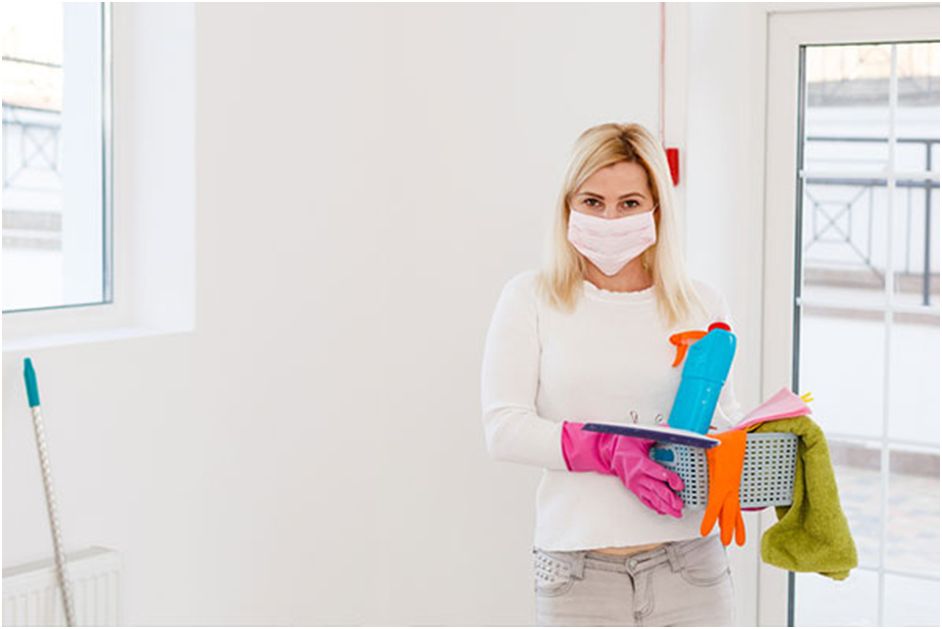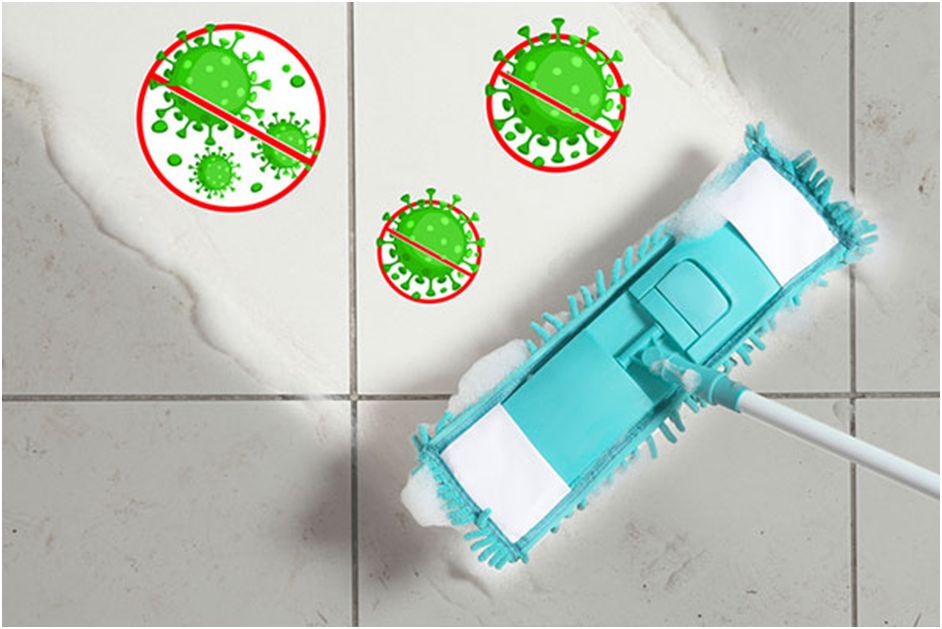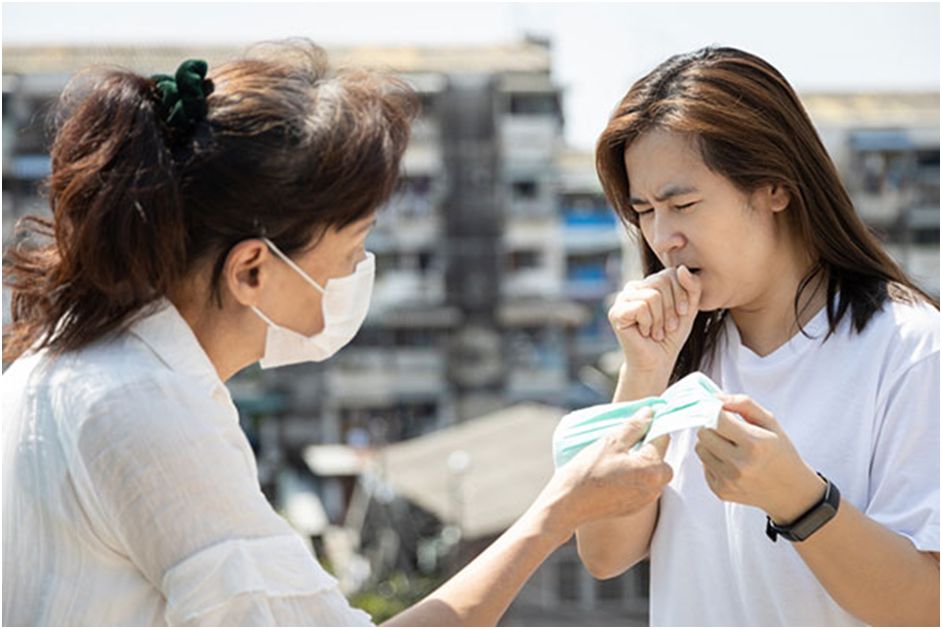
The coronavirus situation shows no signs of slowing down and has put the entire world in a state of discomfort and stress. To prevent things from getting out of hands, the Center for Disease and Control has urged the public to practice personal hygiene and disinfect their living and working spaces religiously.
If there’s one way people can combat the COVID-19 outbreak,it’s by constantly cleaning and sanitizing their homes to keep them and their families safe from the virus. Therefore, people around the world are religiously cleaning and disinfecting to stay safe during the pandemic.
To make things easier for you, we’ve created a guide on how to disinfect and sterilize your home during the COVID-19 outbreak.
Cleaning vs. Disinfecting

Cleaning
While we’re all concerned with keeping our homes, offices, and business spaces free from the Coronavirus, it’s essential to recognize the difference between cleaning and disinfecting.
To put it simply, cleaning means getting rid of any germs, dirt, and impurities from surfaces. It doesn’t kill germs but rather is the act of removing them; it prevents the risk and spread of infection.
Cleaning can be as simple as washing your hands or doing the laundry with the washing machine. The idea is to remove the harmful bacteria and viruses from high-touch areas and spaces to prevent people from transferring the germs to other surfaces.
Be extremely careful with your furniture as well. You must pay special attention to soft surfaces like sofas, couches, rugs, and carpets. They need to be dusted and cleaned to remove any debris, dust, or dirt.
Cleaning surfaces like floor tiles, kitchen counters, dining tables, side tables, doorknobs, and other touch-points is critical at this time. Especially if you have kids running around the house, then you’re more likely to encounter messy areas, clutters, and crumbs all over the place. CHRIStal Clean, Waukesha WI provide preventative sanitization services for your home and office.
They are like to touch surfaces and objects, which is the quickest way to transfer bacteria, so clean all surfaces with dishwashing soap and water.
Disinfecting
On the other hand, disinfecting involves using chemicals to kill the germs and bacteria on every surface. Usually, people just choose to disinfect directly, but the right way is to clean and then disinfect as it helps to decrease the risk of infections and spreading germs.
The CDC has recommended that for people to successfully reduce the chances of spreading the virus, they must first clean all hard surfaces and then disinfect repeatedly with household cleaners and then proceed with disinfection.
It’s easy to get carried away in sterilizing and disinfecting your house but be aware to not use disinfectant chemicals excessively as they can be harmful to our health. When buying cleaning products and disinfectant chemicals, look for items that have no fragrance or dyes and contain at least 70% alcohol.
More ingredients that are approved by the EPA include:
- Hydrogen peroxide
- Lactic acid
- Ethanol (alcohol)
- Citric acid
- Thymol
Products that consist of these ingredients are said to be effective in combating COVID-19 and don’t have adverse health effects on people. If you’re unable to locate products that have these elements, then use what’s available. Once you’ve disinfected the area, go back over the surface using a cloth and water to remove any chemicals deposit and fragrance. It’s advised to keep your kids in a separate room while disinfecting, so they don’t come in contact with any strong chemicals and smells.
Warning: Don’t mix chemicals with other cleaning products as they can release toxic fumes and can be severely harmful.
Hardsurfaces such as floors, counters, doorknobs, and tables are easy to clean. Simply mix the Approved EPA in the recommended ratio, dip a clean washcloth in it, wring excess water and then wipe the surface in repetitive motions to kill the virus.
However, softsurfaces such as carpets, curtains, mattresses, and couches are harder to disinfect. You can try and disinfect them yourself by spraying them with a disinfectant and then rubbing with a wipe drenched in disinfectant. However, to make sure that your soft surfaces are 100% germ-free, it is better to call a professional service.
There are several businesses following the CDC-approved rules to ensure the safety of their clients. Carpet cleaning Epsom, a professional cleaning service, is one of these. They have powerful industrial grade cleaners and disinfectants that rid your soft surfaces of germs easily.
Personaland General Hygiene to Reduce the Spread of the Virus

You might have heard this a hundred times, but washing your hands frequently and thoroughly and exercising social distancing are the most effective ways to keep the virus away from your home.
The right way to wash your hands as instructed by medical experts is to use soap and water for at least 20 seconds to remove any germs. This is the one thing you need to follow yourself and urge your family to do as well. Most importantly, people with kids must ensure that their children adopt the habit of washing their hands frequently throughout the day.
Whether it’s after using the bathroom, coming back after playing in the backyard, before cooking or eating, or collecting a package from outside – washing your hands must always be the first thing you do!
Keep a hand sanitizer on you at all times in case you don’t have a sink or bathroom in proximity. Opt for sanitizers with at least 60% alcohol content as advised by the CDC guidelines to defend against the virus. Try to keep a sanitizer in your car, at home, and on your office desk.
As of now, there seems to be a lack of hand sanitizers in the market, and people might be fearful of stepping outside and going look for one. So, here’s a DIY hand sanitizer you can make from simple ingredients.
What you need:
- Use 2 parts isopropyl alcohol with at least 70% alcohol content
- Take 1 part of aloe vera gel – either fresh or from a tube – or use vegetable glycerin.
Pour these ingredients into a squeeze bottle or flip-top cap bottle and shake until the contents are well combined. You can carry this around when you step outside to grab groceries or keep it in your purse to have a sanitizer on hand. The consistency may differ from store-bought sanitizers as this might be more watery, but it does the job well.
Routine Cleaning and Disinfection of Households and Household Items
Keep the following guidelines in mind when cleaning and disinfecting your home for Coronavirus:
- Tables, cabinets, kitchen counters, toilets, light switches, electronics, faucets, etc. should all be routinely cleaned multiple times a day.
- Cleaning and disinfecting should be done while wearing protective gloves and a mask so that you don’t come in contact with any harmful chemicals. Once done cleaning, gloves should be carefully disposed of. If you’re using reusable gloves, then do not use them for other purposes and assign them for cleaning and disinfecting for COVID-19 only.
- Household members that are self-isolating must clean their respective rooms regularly and use alcohol-based wipes to eliminate any germs or bacteria.
- The clothes, bed covers, pillow covers, and utensils of and an ill person should be cleaned and sterilized separately to avoid contact with the belongings of other house members.
- Any highly-contaminated items should be discarded immediately.
- Make use of steam cleaners, if available on hand, to clean any porous surfaces such as carpets, curtains, rugs.
- If you use mops to clean and sterilize floors, then clean the mop heads with soap and hot water as well. Then leave it to air dry completely before the next use. Do the same technique for cloth as well.
- For electronic devices like laptops, touch screens, mobile phones, keyboards, remote controls, etc. use the appropriate cleaning products or alcohol-based wipes to disinfect the device. Make sure to dry the surface completely before use.
Cleaning Your Home 101: The Complete Guide
Before you begin cleaning, you must wash your hands with soap and water. Then put on a pair of gloves and grab all your cleaning supplies so you can begin. If you don’t have any cleaning products, then make your own with equal parts of vinegar and water in a spray bottle.
This home-made cleaner works splendidly on floors, counters, cabinets, doors, appliances, and all kinds of surfaces. Use a wet or damp washcloth to pick up the dust and impurities from every nook and corner instead of a duster that disperses the particles in the air and cause irritation or allergies. Let’s take you through the places and how they should be cleaned the right way.
1. Kitchen
Most people leave their kitchen for last as they believe it’s the least likely to get dirty or potentially infected. However, it’s one of the most frequented used places in every household.
The place where you prepare food should be at the top of your list for places that should be frequently cleaned and disinfected. Store your cleaners and disinfectant wipes in a cabinet in the kitchen, so you always have the right products on hand.
The high-touch surfacesin every kitchen are normally the counter, refrigerator, cabinets, stove, electrical appliances, and vegetable drawers. Be sure to wipe these down repeatedly throughout the day, so they don’t transfer germs to other items.
Most importantly, wash your metal and silverware, and all other utensils thoroughly to remove any traces of impurities. If you bring grocery bags from outside, dispose of them once used and take out the kitchen trash regularly.
2. Bathroom
Cleaning the bathroom is essential, particularly if you have multiple members sharing one in a household. Everything from the tiles, sink, and faucets down to the last floor tile must be cleaned and disinfected to prevent the virus from surviving.
If you have any cloths or damp towels kept in your bathroom, be sure to wash them in warm water and detergent and then put them out to dry in the sun. COVID-19 virus is known to last longer on wet surfaces than hard, dry ones, so keep your bathroom dry.
Clean the shower curtains, drying mats, light switches, and taps multiple times, so there aren’t any chances of spreading germs or the virus to other people in the house.
3. Laundry
It is recommended to immediately put your clothes in the wash once you come home from outside. Collect laundry in separate clothes hampers, specifically when handling clothes of a sick person so you or any other members, don’t come directly in contact with their clothing.
The ideal way of collecting clothes from around the house would be with disposable or reusable gloves. Avoid shaking the laundry as it can cause the virus to transfer to other surfaces.
Also, wash the clothes in lukewarm water and detergentto thoroughly remove any filth and virus that could be settled on the fabric. Be sure to follow the manufacturer’s instructions on the clothing item and, if suitable, then use the warmest water setting.You can even run the washing machine empty with hot water, washing detergent, and disinfectant to avoid the growth of bacteria. Wash your hands once you’re done laundering the items.
4. Bedroom
Change the bedding and pillow covers of the bedrooms frequently. If you’re cleaning the room of a COVID-19-positive patient, be sure to carefully handle their belongings with gloves and dispose of them immediately when you’re done cleaning.
Cautiously empty their trash and wastebaskets in plastic bags and discard it straightaway. Use a lined trash can for the ill house member and remove garbage with gloves on. While you’re cleaning the rooms, open the windows to promote ventilation and let some fresh air inside.
Then go about cleaning and disinfecting everything and anything the sick member may have touched or used in the room. Once you’ve thoroughly sanitized and disinfected the room, wash your hands with soap and dispose of the gloves in the trash.
Ultimately, if a member of your household coronavirus-positive,then it’s commended to give them a separate space to quarantine effectively, preferably with an attached bathroom. If that space is not shared with anyone else, then it shouldn’t be visited or used by anyone – even for cleaning.
The aim should be to avoid any unnecessary contact with the ill person, so maintain a five-feet distance if you’re sharing the space and clean after yourself, so the virus isn’t spread to others.
Wrapping Up
If you’re a business owner who’s planning to reopen now that lockdown measures have been eased, cleaning and disinfecting your facility are necessary steps to ensure the health and safety of your employees, customers, and yourself. A cleaning and disinfection routine is also essential in your day-to-day operations.
The CDC recommends that businesses develop a reopening plan to prevent the spread of the virus in their establishment and educate their people on COVID-19 safety practices. Many businesses have to reopen or risk closing down forever, and practicing social distancing and safety protocols is the second best way to keep your staff and your customers from catching the virus in your facility.
Follow these recommendations and urge your family members to do the same so you can assure the health and safety of your loved ones. This comprehensive guide highlights the basics of cleaning and disinfecting your home so you can stay safe in these trying times.
Myrah Abrar is a computer science graduate with a passion for web development and digital marketing. She writes blog articles for Carpet Cleaning Epsom.